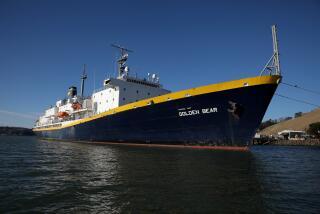Agency Agrees to Evaluate Safety of Radar Facility
- Share via
A federal agency is looking for environmental and radar experts to sit on a three-member panel that will evaluate the safety of the Navy’s Surface Warfare Engineering Facility, which Port Hueneme residents say may be emitting hazardous radiation.
Although Capt. J.W. “Stretch” Phillips, commander of the Naval Surface Warfare Center, insists the five-story radar facility is safe, he says he understands why residents are worried.
Last week the Navy admitted it could not find the environmental reports that allowed the 50,000-square-foot facility to be built. Also, some of the information on radar emissions is classified, making it impossible for residents to know how much radiation exists or whether the levels are harmful.
“Because we can’t produce the documents, it allows the perception to be made that we are hiding something,” Phillips said Tuesday. “We have to convince the majority of the populace that we have taken reasonable steps to ensure their safety.”
The Surface Warfare Engineering Facility, built in 1985 as part of a military construction project, is used to test and evaluate weapons and radar systems and to simulate shipboard problems.
Although several types of radar structures are on the roof of the building, officials say the equipment only emits radiation about 5% of the time and is primarily used to train engineers and fleet members.
Phillips, who has been a commander at the warfare center since June, told the California Coastal Commission that the Navy allowed a “breach of public trust” in the way it handled public concerns over the facility.
Consequently, the Navy, in an effort to rebuild public faith, has agreed to work cooperatively with the Office of Ocean and Coastal Resource Management, the federal agency designated to select panel members.
After panel members are approved by the Navy and the California Coastal Commission next month, the panel will begin reviewing residents’ health concerns and the Navy’s responses.
*
Silver Strand Beach residents, who live several hundred yards from the radar-testing facility, began questioning the Navy about the building in 1996. While fighting a Navy proposal that would have allowed jets to fly at high speeds and low altitudes to test radar equipment, residents said they began to realize how little they knew about the radar building.
Their skepticism grew when Navy officials said they didn’t have the original documentation.
“It was built without any environmental review, so we want a full review of all potential impacts of the radiation on the coastal zone,” said Lee Quaintance, a member of the coastal group Beacon Foundation. “And that includes the safety of the people and the wildlife.”
Quaintance said he was surprised that Phillips conceded the Navy could not find the documentation, and that he admitted a breach of public trust. But Quaintance said he is glad the Navy has agreed to cooperate with federal mediators.
James Raives, federal consistency coordinator for the Coastal Commission, said he doesn’t believe the Navy is intentionally concealing anything. He said he knows that the Navy’s hands are tied by classified information.
But he said he still wants to see a complete environmental report on the facility.
“We’d like to see a third-party review of the data they have,” Raives said. “We want to get information on the impact from the radar facilities on the coastal resources, and we’d like to get this matter resolved one way or the other.”
More to Read
Sign up for Essential California
The most important California stories and recommendations in your inbox every morning.
You may occasionally receive promotional content from the Los Angeles Times.













